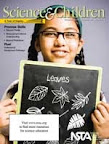Experience being outdoors in nature—how much do we need?
By Peggy Ashbrook
Posted on 2010-09-25
In preschool the lessons about environmental science can be about becoming familiar with and enjoying the environment through outdoor exploration and play, gardening, and fieldtrips, and noticing connections such as, roly-polies and slugs are usually found in cooler damp places and when the grass turns brown. Caring for the environment relates to what is within children’s control—leaving spaces cleaner than we found them by cleaning up after ourselves and not messing up others (Nature’s) work. I believe that if children develop a love for the natural world they will be good stewards as they grow older—to the extent that is appropriate for their age and if they have the information about how their actions can reduce negative environmental changes. For example, children may litter without thinking about where the trash should go. In early childhood we can teach children to tidy up after themselves in all areas, creating a habit. If in addition children have opportunities to observe wildlife–plants and animals, from ants to birds to deer—they may develop a love of nature, and can reason that they want to clean up to preserve it.
 Can you feel connected to nature as an adult if you haven’t experienced this as a child? Can anyone tell me about adults who are now inclined to be outside but were nature/environmentally deprived as children? I’m wondering about how much nature is enough when I compare some of the programs I work in to programs I’ve read about which operate outdoors, all day, every day, except in extreme weather, such as Cedarsong Nature School in Vashon Island in Washington state. Watch videos about learning these children are doing in the woods from KOMO4 News and the Seattle Times in Seattle, WA and read the news articles to get a bit more detail: Mike Esterl ‘s article in the April 14, 2008, Wall Street Journal describes a parent’s attitude toward a possible danger of forest schools–ticks, and Rosemary Bennett’s article in the October 6, 2009, Sunday Times about forest schools in Europe, including the Secret Garden Nursery in the Howe of Fife, in Scotland.
Can you feel connected to nature as an adult if you haven’t experienced this as a child? Can anyone tell me about adults who are now inclined to be outside but were nature/environmentally deprived as children? I’m wondering about how much nature is enough when I compare some of the programs I work in to programs I’ve read about which operate outdoors, all day, every day, except in extreme weather, such as Cedarsong Nature School in Vashon Island in Washington state. Watch videos about learning these children are doing in the woods from KOMO4 News and the Seattle Times in Seattle, WA and read the news articles to get a bit more detail: Mike Esterl ‘s article in the April 14, 2008, Wall Street Journal describes a parent’s attitude toward a possible danger of forest schools–ticks, and Rosemary Bennett’s article in the October 6, 2009, Sunday Times about forest schools in Europe, including the Secret Garden Nursery in the Howe of Fife, in Scotland.
Jenny, Australian preschool teacher at “a progressive school nestled in the beautiful Australian bush” and blogger, shares other sites:
Mother Earth School in Portland, OR, the Carp Ridge Forest Preschool near Carp, Ontario, the Tusseladden nursery program in Norway, and the “I Ur och Skur” program in Sweden.
Some early childhood programs such as Shining Star Waldorf School in Portland, OR and Mountain View Parent Nursery School in Mountain View, CA, offer a one-day-a-week outdoor program in addition to an indoor-outdoor preschool program.
 “As children ran their palms along the rough bark of horse chestnut trees or gently cradled a toad, they would have experiences unavailable to them at school, with potential to augment and enrich their classroom science curriculum.” Read more about a collaboration which supported children’s growing understanding of science inquiry and basic life science concepts in A Walk in the Woods in the October 2010 issue of Science and Children. Authors Cindy Hoisington, Nancy Sableski, and Imelda DeCosta fully describe the Head Start-Arboretum project, not an all outdoor preschool but a series of four fieldtrips, offering us a path to follow into the woods.
“As children ran their palms along the rough bark of horse chestnut trees or gently cradled a toad, they would have experiences unavailable to them at school, with potential to augment and enrich their classroom science curriculum.” Read more about a collaboration which supported children’s growing understanding of science inquiry and basic life science concepts in A Walk in the Woods in the October 2010 issue of Science and Children. Authors Cindy Hoisington, Nancy Sableski, and Imelda DeCosta fully describe the Head Start-Arboretum project, not an all outdoor preschool but a series of four fieldtrips, offering us a path to follow into the woods.
Full disclosure: As a child I spent many happy hours in the woods behind my house after school and in the summer and I am definitely biased towards spending time in nature!
Peggy
Disclaimer: The views expressed in this blog post are those of the author(s) and do not necessarily reflect the official position of the National Science Teaching Association (NSTA).


